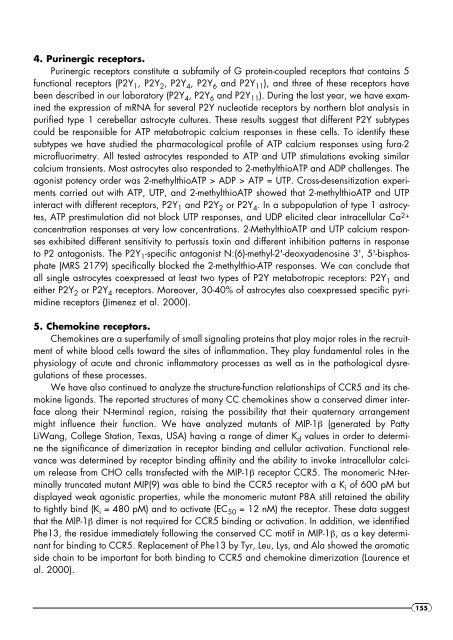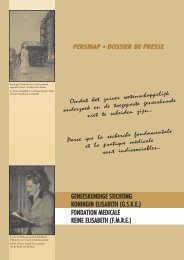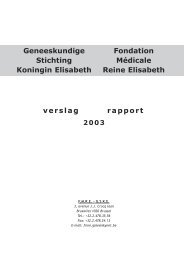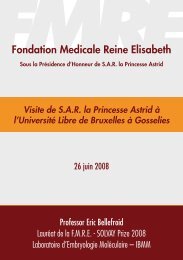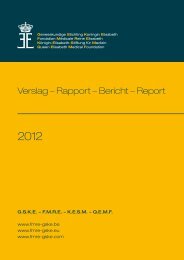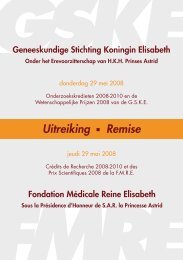Geneeskundige Stichting Koningin Elisabeth ... - GSKE - FMRE
Geneeskundige Stichting Koningin Elisabeth ... - GSKE - FMRE
Geneeskundige Stichting Koningin Elisabeth ... - GSKE - FMRE
Create successful ePaper yourself
Turn your PDF publications into a flip-book with our unique Google optimized e-Paper software.
4. Purinergic receptors.<br />
Purinergic receptors constitute a subfamily of G protein-coupled receptors that contains 5<br />
functional receptors (P2Y 1, P2Y 2, P2Y 4, P2Y 6 and P2Y 11), and three of these receptors have<br />
been described in our laboratory (P2Y 4, P2Y 6 and P2Y 11). During the last year, we have examined<br />
the expression of mRNA for several P2Y nucleotide receptors by northern blot analysis in<br />
purified type 1 cerebellar astrocyte cultures. These results suggest that different P2Y subtypes<br />
could be responsible for ATP metabotropic calcium responses in these cells. To identify these<br />
subtypes we have studied the pharmacological profile of ATP calcium responses using fura-2<br />
microfluorimetry. All tested astrocytes responded to ATP and UTP stimulations evoking similar<br />
calcium transients. Most astrocytes also responded to 2-methylthioATP and ADP challenges. The<br />
agonist potency order was 2-methylthioATP > ADP > ATP = UTP. Cross-desensitization experiments<br />
carried out with ATP, UTP, and 2-methylthioATP showed that 2-methylthioATP and UTP<br />
interact with different receptors, P2Y 1 and P2Y 2 or P2Y 4. In a subpopulation of type 1 astrocytes,<br />
ATP prestimulation did not block UTP responses, and UDP elicited clear intracellular Ca 2+<br />
concentration responses at very low concentrations. 2-MethylthioATP and UTP calcium responses<br />
exhibited different sensitivity to pertussis toxin and different inhibition patterns in response<br />
to P2 antagonists. The P2Y 1-specific antagonist N:(6)-methyl-2'-deoxyadenosine 3', 5'-bisphosphate<br />
(MRS 2179) specifically blocked the 2-methylthio-ATP responses. We can conclude that<br />
all single astrocytes coexpressed at least two types of P2Y metabotropic receptors: P2Y 1 and<br />
either P2Y 2 or P2Y 4 receptors. Moreover, 30-40% of astrocytes also coexpressed specific pyrimidine<br />
receptors (Jimenez et al. 2000).<br />
5. Chemokine receptors.<br />
Chemokines are a superfamily of small signaling proteins that play major roles in the recruitment<br />
of white blood cells toward the sites of inflammation. They play fundamental roles in the<br />
physiology of acute and chronic inflammatory processes as well as in the pathological dysregulations<br />
of these processes.<br />
We have also continued to analyze the structure-function relationships of CCR5 and its chemokine<br />
ligands. The reported structures of many CC chemokines show a conserved dimer interface<br />
along their N-terminal region, raising the possibility that their quaternary arrangement<br />
might influence their function. We have analyzed mutants of MIP-1β (generated by Patty<br />
LiWang, College Station, Texas, USA) having a range of dimer K d values in order to determine<br />
the significance of dimerization in receptor binding and cellular activation. Functional relevance<br />
was determined by receptor binding affinity and the ability to invoke intracellular calcium<br />
release from CHO cells transfected with the MIP-1β receptor CCR5. The monomeric N-terminally<br />
truncated mutant MIP(9) was able to bind the CCR5 receptor with a K i of 600 pM but<br />
displayed weak agonistic properties, while the monomeric mutant P8A still retained the ability<br />
to tightly bind (K i = 480 pM) and to activate (EC 50 = 12 nM) the receptor. These data suggest<br />
that the MIP-1β dimer is not required for CCR5 binding or activation. In addition, we identified<br />
Phe13, the residue immediately following the conserved CC motif in MIP-1β, as a key determinant<br />
for binding to CCR5. Replacement of Phe13 by Tyr, Leu, Lys, and Ala showed the aromatic<br />
side chain to be important for both binding to CCR5 and chemokine dimerization (Laurence et<br />
al. 2000).<br />
155


